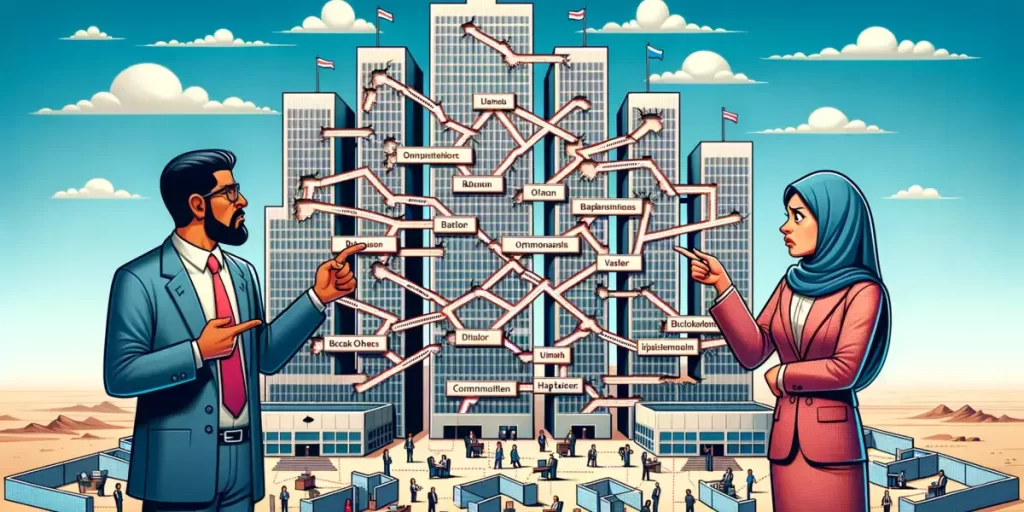Barriers to business communication are common occurrences in the workplace that can lead to misunderstandings, poor retention, and hampered productivity. Communication is essential to any organization, and the free flow of information must be maintained for the business to thrive. However, communication may be impeded by various factors, including psychological, organizational, social, and cultural barriers.
One of the most significant barriers to business communication is the hierarchical structure of organizations. The number of managerial levels may limit the flow of communication, and people at the top may need to be more receptive to communication from subordinates. Additionally, the message’s sender may sometimes be the right person at the right time, leading to miscommunication. Communication channels must be clear and timely to ensure the receiver understands the intended message.
Another common barrier to business communication is technical terms and jargon. When technical terms are used, it may create communication barriers, especially when the receiver and sender have different communication preferences or cultural backgrounds. Lack of clarity in communication can also lead to misunderstandings, and the receiver may interpret the message in various meanings. It is essential to ensure that communication is clear and concise and that nonverbal cues are considered to improve organizational communication.
Contents
Barriers to Business Communication
Different Communication Styles
One of the most common barriers to business communication is differences in communication styles. People from different backgrounds, cultures, and regions often communicate differently, which can lead to misunderstandings and misinterpretations. For example, some people prefer direct communication, while others prefer indirect communication. Some people may use humor or sarcasm, while others may find it offensive.
Time Pressure
Time pressure is another major barrier to effective communication in the workplace. When people are under pressure to meet deadlines or complete tasks, they may not take the time to communicate clearly or listen to others. This can lead to misunderstandings, mistakes, and missed opportunities.

Lack of Strong Leadership
A lack of strong leadership can also be a barrier to effective communication. When leaders are clear about their expectations and provide clear guidance, it can be easier for employees to communicate effectively. This can lead to confusion, frustration, and a lack of productivity.
Client Demands
Client demands can also be a barrier to effective communication. When clients have specific requirements or expectations, it can be difficult for employees to communicate effectively. This can lead to misunderstandings, missed deadlines, and lost business.
Personal Differences Among Colleagues
Personal differences among colleagues can also be a barrier to effective communication. When people have different personalities, values, and beliefs, it can be difficult for them to communicate effectively. This can lead to conflicts, misunderstandings, and a lack of productivity.
Ineffective Tools and Technologies
Ineffective tools and technologies can also be a barrier to effective communication. When people need access to the right tools or technologies, it can be easier for them to communicate effectively. This can lead to delays, mistakes, and a lack of productivity.
Corporate Culture
Corporate culture can also be a barrier to effective communication. When people are not aligned with the values and goals of the organization, it can be difficult for them to communicate effectively. This can lead to conflicts, misunderstandings, and a lack of productivity.
Financial Pressure
Financial pressure can also be a barrier to effective communication. When organizations are under financial pressure, they may not invest in the right tools or technologies or provide adequate training and support. This can lead to delays, mistakes, and a lack of productivity.
Unclear Responsibilities
Unclear responsibilities can also be a barrier to effective communication. When people need to be clearer about their roles and responsibilities, it can be difficult for them to communicate effectively. This can lead to conflicts, misunderstandings, and a lack of productivity.
Use of Jargon
Finally, jargon can also be a barrier to effective communication. When people use technical or specialized language that others need help understanding, it can be difficult for them to communicate effectively. This can lead to misunderstandings, mistakes, and a lack of productivity.

Impact of Communication Barriers
Reduced Productivity
Communication barriers can have a significant impact on productivity in the workplace. When employees cannot communicate effectively, it can lead to delays, errors, and decreased overall efficiency. This can result in missed deadlines, increased costs, and, ultimately, a decrease in profits.
Misunderstandings and Misinterpretations
One of the most common communication barriers is misunderstanding or misinterpretation of information. This can occur when a language barrier or the message is unclear or ambiguous. Misunderstandings can lead to confusion, frustration, and even conflict in the workplace. Employees need to be clear and concise in their communication to avoid misunderstandings.
Poor Retention of Information
When communication is ineffective, it can also lead to poor retention of information. Employees may need to remember important details or instructions, leading to mistakes and errors. This can be particularly problematic in industries where safety is concerned, such as healthcare or construction.
In conclusion, communication barriers can significantly impact productivity, understanding, and retention of information in the workplace. Employers should address these barriers, such as providing training in effective communication, using visual aids or diagrams to clarify information, and encouraging open and honest communication between employees. By doing so, they can help to improve communication and, ultimately, the success of their business.
Overcoming Barriers to Business Communication
Regarding business communication, several barriers can hamper the free flow of information and impede productivity. However, these barriers can be overcome by implementing effective communication techniques and improving communication channels.
Effective Communication Techniques
To communicate effectively, it is essential to ensure that the message is clear and concise. The message’s sender should use simple language and avoid technical terms the receiver may need help understanding. Additionally, the message should be tailored to the communication needs of the receiver, and the right person should receive it at the right time.
Active listening is another essential technique that can help overcome communication barriers. By paying attention to nonverbal cues and filtering points, the receiver can ensure that the intended message is understood, leading to better communication and fewer misunderstandings.
Improving Communication Channels
Inadequate communication channels can also hamper effective communication. Formal communication channels, such as complaint and suggestion boxes, can be implemented to ensure employees have a platform to communicate their thoughts and ideas. Additionally, upward communication can be encouraged to ensure that information flows from the bottom to the top of the organization.
Improving the process of communication can also have a significant impact on its effectiveness. Clear and timely communication ensures that the receiver receives and understands the message, leading to better communication and fewer misunderstandings.
In conclusion, by implementing effective communication techniques and improving communication channels, businesses can overcome barriers to communication. This can lead to better productivity, fewer misunderstandings, and a more positive work environment.
Consequences of Ineffective Communication in Business
When communication breaks down in a business, the consequences can be severe. Poor communication can lead to misunderstandings, mistakes, and missed opportunities. It can also create a tense work environment, where employees need to be more motivated to be productive and may even become disgruntled.

One of the biggest consequences of ineffective communication is a loss of time and money. According to a study by Q4intel, businesses can lose as much as $47.37 per employee each day due to poor communication. This lost time is spent resolving communication issues, addressing mistakes caused by misunderstandings, and following up on unmet deadlines and deliverables. These activities can take up to 19% of a team’s workweek, which can significantly impact a company’s bottom line.
Ineffective communication can also lead to missed opportunities. When employees do not communicate effectively with each other or clients, they may miss out on important information that could help them make better decisions. This can lead to missed sales, lost contracts, and other missed opportunities that can impact a company’s growth and success.
Another consequence of poor communication is low morale. Employees may become disengaged and unmotivated when they feel they need to be heard or their contributions are not valued. This can lead to a decrease in productivity and an increase in turnover, which can be costly for a business.
Finally, ineffective communication can lead to a breakdown in trust. When employees feel they cannot trust their colleagues or managers to communicate honestly and effectively, it can create a toxic work environment. This can lead to poor collaboration and teamwork, further impacting a company’s success.
Overall, the consequences of ineffective communication in business can be severe. It is important for companies to prioritize effective communication and to invest in training and resources to help employees communicate more effectively. By doing so, businesses can avoid the negative consequences of poor communication and create a more productive, successful, and positive work environment.
Conclusion
Effective communication is critical to the success of any business. However, several barriers to business communication can impede its effectiveness. These barriers can be attributed to the sender or receiver, resulting in misconceptions, filtering, selective perception, and emotional disconnects.
Semantic barriers arise when the sender and receiver understand the same word or phrase differently. Psychological barriers may arise when the receiver has a preconceived notion about the sender or message. Personal barriers can be caused by language, culture, age, or gender.
To overcome these barriers, businesses must proactively improve their communication processes. These steps can include providing adequate information to employees, using clear and concise language, avoiding jargon, and actively listening to feedback.
It is also important for businesses to create a culture that values open and honest communication. This can be achieved by encouraging employees to share their ideas and opinions, providing training on effective communication, and addressing any communication issues as they arise.
Boko Ducky has over 10 years of experience in helping individuals and organizations improve their communication skills.



